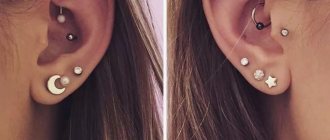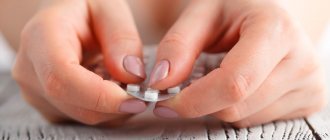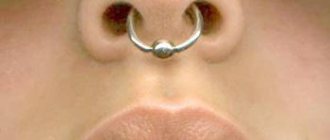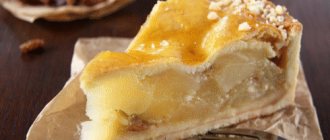Dangers of Piercing
It must be remembered that piercing is not a cosmetic procedure, but a surgical one. Therefore, it must be performed in a sterile office; the technician must have disposable gloves, needles and other consumables.
In front of you, he should put the piercing jewelry in a disinfectant solution and ask about your reaction to anesthesia, blood clotting, etc. The technician will definitely tell you about the possible dangers of the puncture and how to properly care for it.
The most common problems that arise after a puncture are:
Festering (abscess) is a natural process, but it usually lasts several days. If you regularly wash the puncture site and do not disturb the jewelry, then there should be no problems with healing and the decay will soon pass.
Allergies to metals appear quite often. Redness, rash, peeling, itching indicate that you should change your jewelry.
Infection and blood poisoning (sepsis) occur when sterility is not maintained. Characterized by swelling, pain, and purulent discharge. If the condition does not improve 3 days after the piercing, you should contact your piercer or doctor.
Keloids are tumors at the puncture site (see picture on Google).
Deterioration of vision.
Risks of piercing
As for reverse piercing, if the puncture was performed by a specialist, there is a minimal likelihood of side effects , which most often depend on the individual characteristics of the human body.
Wound suppuration is the most common phenomenon. To avoid this, you should choose jewelry made from hypoallergenic materials.
It is not recommended to insert silver immediately after a puncture, and cobalt and nickel alloys can cause an allergic reaction.
Nipple piercings done incorrectly can damage the milk ducts. If you choose the wrong place for a puncture on the eyebrow, you can hit the nerve plexuses and partially paralyze the facial muscles. You should not pierce your ear uncontrollably, as this may impair your hearing. If your tongue is pierced, you will have difficulty speaking and eating. They get used to it within two weeks. When piercing the navel, it is important to choose the right thickness of the jewelry, otherwise the wound will take a very long time to heal. During pregnancy, it is better to remove the piercing altogether. Then you will need to re-puncture.
No one can forbid you to express your individuality, but before you decide to take this step, weigh the pros and cons and turn only to professionals.
Piercing Care
During the first few days, pus and lymph will be released from the puncture. You can’t pick out these cool dried things, no matter how much you want to. They should be removed with a cotton swab dipped in a disinfectant solution or make a cotton compress from the same. Under no circumstances should you touch the puncture with dirty hands.
For the first couple of weeks after the piercing, you should avoid going to the sauna, swimming pool, or even just a hot bath. You should not swim in the sea, because salt water interferes with healing, and there is a high risk of getting an infection.
You cannot remove or even just touch the jewelry until the puncture is completely healed. Forget about the fact that you need to “pull” it in the hole so that it does not overgrow - this was invented by little-informed women in hairdressing salons who make holes in their ears with a pistol.
It is worth limiting (ideally eliminating) alcohol consumption in the first two weeks after the puncture. If you did drink the night before, wait for the puncture to fester in the morning.
Vitamin C (ascorbic acid), multivitamins and zinc-containing foods speed up the healing process in the first weeks.
An important question is how to wash the puncture site. Many people use hydrogen peroxide and this is a big mistake. The fact is that peroxide is a drug for stopping blood, but not for sterilization. Alcohol, furatsilin, potassium permanganate, chamomile tincture and cologne are also not suitable. chlorhexidine and miramistin should be used to wash the puncture . In addition, there are special products for caring for piercings - H2Ocean, Dr. Piercer. The frequency of washing is every 3-4 hours.
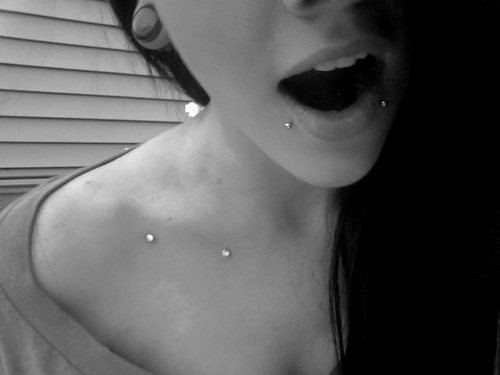
Piercing "for" or "against"
Since piercing has gained popularity, there have been many conflicting opinions about this body modification. It is useless to argue about the advisability of piercing, since everyone has their own point of view and facts to support it. But for those who have not yet decided for themselves whether to do or not to get a piercing, they will have to carefully understand this issue.
A little history
Let's start with the history of piercing. Archaeological finds indicate that the custom of piercing various parts of the body dates back more than 5,000 years. But in each tribe, piercing was done for different purposes and had different meanings. Punctures of various parts of the body could be part of rituals, distinctive signs of social affiliation, and were also done with the aim of influencing acupuncture points. For a long time, piercing was unacceptable in a civilized society, but in the 60s, in America, as a result of an advertising campaign, piercing became popular in almost all segments of the population, from ordinary workers to show business stars.
What is the purpose of body piercing in our time? Fashion trends are a compelling argument for many, but if you think about it, not all ardent fashion followers want to decorate themselves with piercings. And, therefore, there are other motives for getting a piercing. If the reason is only the desire to keep up with fashion, then do not rush - fashion will pass, but the puncture mark may remain for a long time. You also need to understand that any impact on biologically active points can have both positive and negative consequences. Most often, the place for piercing is chosen subconsciously, and this is exactly the case when piercing is done not only for beauty, but guided by deep motives.
Useful tips
And in order to protect yourself from problems that may arise due to mistakes during piercing, let’s see what the professionals recommend.
- The most important thing is to choose a master.
Of course, failures happen to everyone, and a lot depends on the individual reaction to the puncture, to the product and care products. But a professional and experienced technician will reduce all risk to zero, provide competent advice, and if problems arise, he will be able to correctly identify and eliminate the causes. - Choice of anesthesia.
This is especially important, since it is unsuccessful pain relief that most often leads to dire consequences. If you have allergies or other negative reactions to medications, you must inform the specialist in advance. - Product selection.
For piercing you need to use only high-quality certified products, preferably from companies with a good reputation. Products are usually made from medical steel, steel for implantation, zirconium, acrylic, as well as bone and moisture-resistant wood (boxwood, ebony). It is highly undesirable to use gold and silver, since due to impurities of other metals, such products can cause allergic reactions and irritation. But, in individual cases, high-grade gold is well tolerated. - Puncture care.
The time and quality of healing will depend on the correct choice of care products and regular hygiene procedures. It is strictly forbidden to use such products as alcohol and hydrogen peroxide. Such preparations have disinfectant properties, but at the same time they burn the edges of the wound, and the piercing will take a very long time to heal, which increases the risk of infection. Most often, Levomikol ointment and chlorhexidine bigluconate are used for care. - Aftercare.
If subsequently, even after healing, the piercing was subjected to physical impact (the product caught on things, or the puncture site was injured), then it is necessary to treat the puncture and the product.
Piercing can decorate, it can frighten, it can enhance sexuality, and it can cause gossip and condemnation. And, having decided to get a puncture, you need to be prepared not only for admiring glances. Many people have to defend their right to choose for a long time, not only in front of strangers, but also in front of loved ones. True, this can be a good test for others, because if they love and respect a person, then jewelry and piercings on the body will not affect their attitude.
Does it hurt?
A common but very stupid question. The painfulness of the procedure depends on the individual pain threshold of the person and the professionalism of the piercer. There have been many attempts to rate the pain of a piercing, and if you average these data, you get the following piercing pain ratings:
All about pregnancy tests
Myths about the dangers of solarium
How to get rid of body hair?
Types of piercing
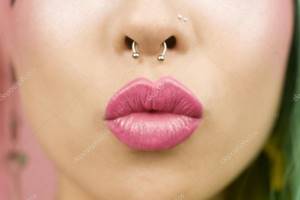
If you have already finally decided to modify your body, it’s time to decide which piercing and in which place to do it. Let's start with the parts of the body that can be pierced: nose, upper and lower lip, eyebrows, cheeks, ears, navel, nipples, tongue, intimate piercing, tailbone.
But it is extremely undesirable to do piercing on these parts of the body, although there are also extreme sports enthusiasts: eyelids, lower jaw, uvula, horizontal tongue piercing. Punctures in these places take a long time to heal and often lead to serious health consequences.
There are types of piercings on each part of the body, for example, the lip can be pierced on the top or bottom, in the middle, on the left or right side. There are 5 variations of ear piercings, and 4 types of eyebrow and nose piercings. Each type of piercing has its own name.
Types of piercing jewelry
Piercing jewelry is striking in its variety: earrings made of surgical steel, PTFE alloys, silver, gold and titanium, with precious and semi-precious stones. Jewelry can have a simple design or be intricately shaped and complex. When choosing an accessory for yourself, pay attention to the following points:
- Jewelry made from surgical steel can negatively affect the healing process and also lead to the release of harmful and hazardous substances into the blood.
- It is not recommended to use silver and gold jewelry immediately after the puncture; you should wait until complete healing, as there is a risk of inflammation and allergic reactions.
- Piercing earrings made of PTFE alloys are ideal for those who are prone to allergic reactions, since these materials are hypoallergenic.
- Titanium products are recommended to be used immediately after the puncture until healing; they promote rapid tissue restoration.
- Avoid cheap products made from questionable materials, they can lead to inflammation and blood poisoning.
According to their shape, piercing products are divided into 4 types: barbell, ring, banana, labret. The barbell is used to pierce the tongue, bridge of the nose or nipples; it is a straight earring topped with balls or sharp cones at both ends. The ring is placed in the ears, navel or nipples. Banana is a curved barbell that is great for eyebrow and ear piercings. A labret is an earring with a ball or sharp cone on one side and a flat surface on the other. Labret is used for piercings of the nose, lips and ears.
